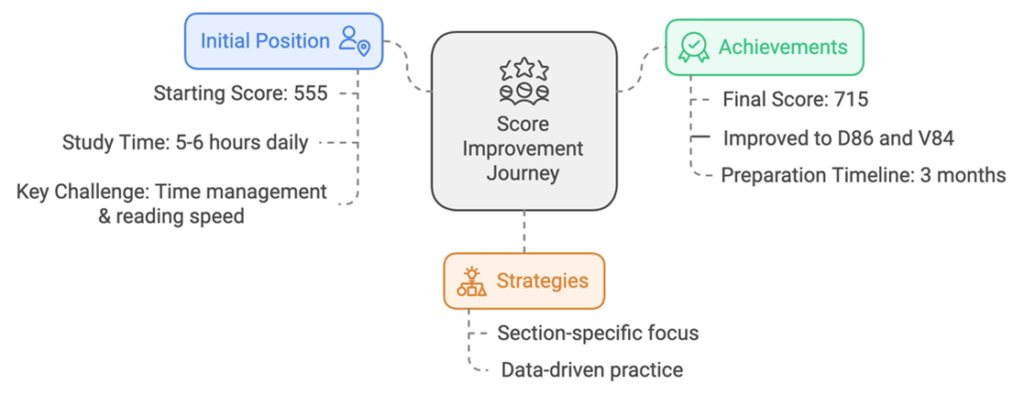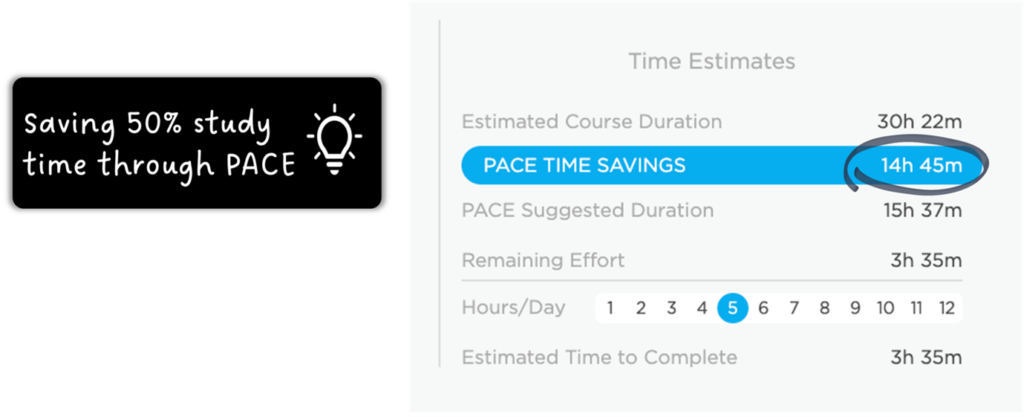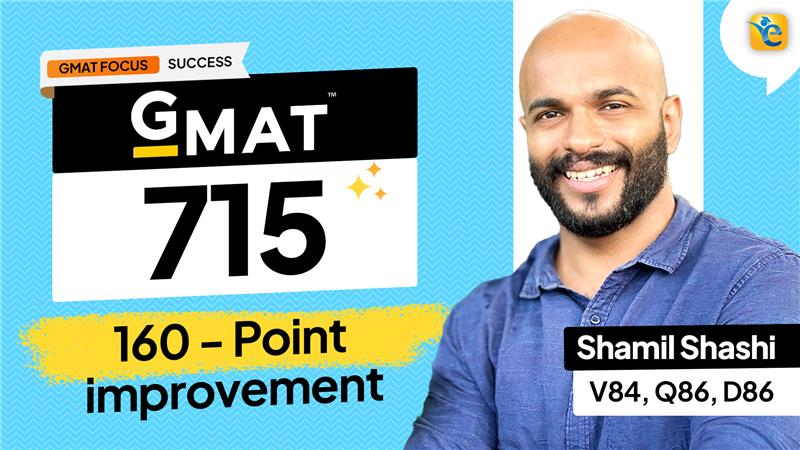For most GMAT aspirants, a 160-point score improvement takes months of dedicated preparation. For Shamil, a working professional with limited study time, this transformation happened in just three months – culminating in a remarkable 715 with elite sectional scores of V84, Q86, and D86.
As a professional juggling work commitments, Shamil faced the common challenge of time management. After registering with e-GMAT in May 2024, an intense project consumed his June entirely. When July arrived, he had just three months to prepare for his target application deadlines. His initial diagnostic score of 555 reflected his starting point as a non-native English speaker with limited reading practice.
What transformed this journey from challenging to triumphant was a methodical, data-driven approach to each GMAT section. Rather than attempting to tackle everything at once, Shamil broke down his preparation into focused segments, leveraging analytics to identify and improve specific weaknesses. This strategic shift would prove crucial in his rapid improvement.

The path to a 160-point improvement began with a clear understanding of the obstacles ahead. For Shamil, these challenges would shape his entire preparation strategy and ultimately influence his approach to each GMAT section.
Initial Challenges
Beyond the limited preparation window, Shamil faced a more fundamental time management challenge: his reading speed. As a non-native English speaker, he initially required up to three minutes just to read and comprehend each verbal question. This timing issue cascaded across sections – in his early practice sessions, he rarely completed more than 15 or 16 questions out of 20 in either the Verbal or Data Insights sections.

The turning point came with the implementation of a structured, data-driven approach. Instead of trying to plan everything manually (despite being “an Excel person”), Shamil leveraged e-GMAT’s personalized study plan. Based on his initial score and available study time of 5-6 hours daily, the platform created a comprehensive schedule that eliminated the need for additional planning.

“The platform gave me a personalized study plan throughout the whole period of three months,” Shamil explains. “Every single day I had to get up, prepare my coffee, and straightaway login to e-GMAT and just start studying. Because it gave me my daily targets and everything was fully prepared for me. I just had to listen to the classes, do the quizzes, practice, revise.”
This systematic approach transformed his preparation from scattered efforts to focused execution. Each day had clear objectives, and more importantly, measurable outcomes that would guide the next day’s study focus. This structure proved crucial in making the most of his limited preparation time while ensuring comprehensive coverage of all topics.
With a structured plan in place, the next challenge was to address each GMAT section systematically. The Verbal section, with its initial score of V78, would be the first testing ground for this new approach.
Verbal Section Transformation: From V78 to V84
The journey to a V84 began with a critical realization: despite having an engineering background and feeling more confident about Quant, Verbal couldn’t be taken lightly. Shamil’s transformation in this section came through mastering the two key components: Critical Reasoning and Reading Comprehension.
Shamil’s Verbal Transformation to V84
Critical Reasoning Evolution
The breakthrough in Critical Reasoning came through implementing the pre-thinking approach, which dramatically reduced question completion time while improving accuracy, as we can see below.

CRITICAL REASONING TRANSFORMATION
Before Implementation:
- 3+ minutes per question
- Random answer selection due to time pressure
- Struggling with assumption questions
After Implementation:
- 90 seconds per question
- Pre-thought scenarios before reviewing options
- 65% accuracy (min. 85%ile ability) on hard questions
“After implementing the pre-thinking approach, even though my reading speed didn’t increase dramatically, I could complete a question in 90 seconds,” Shamil explains. “Before reading the options, I knew what to expect. I would have two scenarios in mind, which would definitely be the answer.”
Reading Comprehension Strategy
For Reading Comprehension, Shamil developed a unique approach that leveraged his UPSC (Indian Civil Services) background knowledge. Instead of getting overwhelmed by complex passages, he used his familiarity with topics like governance, technology, and social issues to grasp main ideas quickly.
READING COMPREHENSION APPROACH
Initial Strategy:
- Taking detailed notes
- Word-by-word reading
- Struggling with time management
Refined Method:
- No note-taking
- Topic familiarity leverage
- Question-first approach for complex passages
A key insight emerged during practice: harder passages didn’t necessarily mean harder questions. “The longer the passage… the simpler the questions tended to be,” Shamil notes.
“They give a lot of information, but at the end, the question might be straightforward.”
Practice Implementation
The improvement from V78 to V84 was supported by systematic practice through Scholaranium:
PRACTICE STRATEGY
- Custom quizzes for specific question types
- Focus on assumption and bold-face questions
- Regular timing analysis and adjustment
The results speak for themselves – accuracies on hard questions that predict his 90th percentile V84 score.

While the Verbal transformation was significant, the Quantitative section would require its own unique approach, particularly in optimizing study time through the PACE algorithm.
Quantitative Section: Strategic Evolution to Q86
While Shamil’s initial Quant score of Q81 was strong, achieving Q86 required a precise, efficiency-focused approach.His approach centered on three key elements: efficient content coverage, thorough topic mastery, and systematic practice.
PACE Implementation
The cornerstone of Shamil’s Quant preparation was the effective use of e-GMAT’s PACE (Personalized Adaptive Course Engine) system.
“For each subtopic, the platform asked for a diagnostic quiz,” Shamil explains. “According to your performance, it modifies the upcoming subsections.”
This adaptive approach led to remarkable efficiency, as in the case of Algebra, where he could save almost 15 hours of study time.

PACE OPTIMIZATION RESULTS
- Time Saved: 44 study hours
- Coverage: Full syllabus
- Method: Customization atomic learning pathway
- Result: Improved ability with limited study time
Shamil saved 44 hours through e-GMAT’s PACE Engine
The system’s efficiency recommendations were particularly effective in foundational topics. After scoring well in diagnostic quizzes for topics like Time and Distance, Shamil could optimize his study time while ensuring concept mastery.
Practice Evolution
Shamil’s practice methodology evolved from basic concept reinforcement to mastery of advanced applications. His approach included:
Regular Scholaranium sessions focused on:
- Word problems mastery
- Application on hard questions
- Error pattern analysis
Complemented by:
- Strategic sectional mock tests
- Topic-specific deep dives
- Consistent performance tracking
As we can see with Number Properties -this focused approach led to a dramatic increase in accuracy

This systematic approach to Quant preparation, combining efficient study methods with thorough coverage, created a strong foundation for his Q86 score. However, the most dramatic transformation in his GMAT journey was yet to come in the Data Insights section, where focused preparation in the final two weeks led to a remarkable improvement from D74 to D86.
Data Insights: The Game-Changing Transformation
The leap from D74 to D86 in Data Interpretation proved to be one of the most crucial elements of Shamil’s 715 score. This transformation is particularly noteworthy because DI was initially his least prioritized section.
Shamil’s DI Transformation to D86
Like many GMAT aspirants, Shamil began with a common misconception: “There’s a belief in the market that DI will be covered with your Quant preparation,” he explains. This led to minimal DI focus before his first attempt, resulting in a score that highlighted the need for dedicated attention.
Key limitations in his initial approach:
- Skipping Multi-Source Reasoning (MSR) questions
- Incomplete passage reading
- Random guessing under time pressure
Strategic Shift
After his first attempt, Shamil’s mentor identified DI as a potential score booster. This led to a focused two-week transformation strategy:
DI PREPARATION EVOLUTION
Before Strategic Shift:
- Minimal dedicated practice
- Section often incomplete
- Basic approach to passages
After Implementation:
- Daily targeted practice
- Subsection-specific focus
- Strategic time management
- Complete section coverage
A particular breakthrough came in handling Multi-Source Reasoning questions. Shamil discovered a counter-intuitive insight: “The longer the MSR passage, with its multiple tabs, the simpler the question tends to be. They give a lot of information, but often the question itself is straightforward.”
This realization led to a refined approach:
- Quick overview of all tabs
- Direct focus on questions
- Strategic information location
- Efficient time allocation
Practice Implementation
The final two weeks involved intensive practice through:
- Daily Scholaranium quizzes focused on DI
- Specific practice for each DI question type
- Timed section simulations
- Regular performance tracking
This focused preparation yielded remarkable results.

The DI transformation demonstrates a crucial GMAT preparation principle: focused, strategic preparation can lead to significant improvements, even in a short timeframe. This section’s dramatic improvement played a vital role in achieving the final 715 score.
Last Mile Push: Transforming 645 to 715 in Two Weeks
The period between Shamil’s first attempt (645) and final score (715) demonstrates the impact of structured mentorship and targeted improvement strategies. The Last Mile Push (LMP) program proved to be the catalyst for this 70-point improvement.
How did LMP help Shamil achieve 715
Mentorship Impact
Shamil joined the LMP program immediately after his first attempt, gaining access to focused mentorship that transformed his preparation approach:
MENTORSHIP EFFECTIVENESS
Initial State (645):
- Unidentified weak areas
- Generic practice patterns
- Section imbalance (DI neglected)
After Mentorship:
- Clear gap identification
- Daily micro-targets
- Balanced section focus
- Strategic adjustments
“The mentorship made my whole preparation very mechanical,” Shamil notes. “I didn’t have to research anything myself because the mentors helped identify those gaps and provided targeted solutions.”
Strategic Adjustments
The LMP program implemented three critical changes:
- Data-Driven Focus
- Regular performance analysis
- Weak area identification
- Targeted improvement metrics
- Time Management Refinement
- Strategic break utilization
- Section-wise timing adjustments
- Optimal question sequencing
- Mental Preparation
- Pre-section meditation
- Performance isolation (preventing one section from affecting others)
- Confidence maintenance strategies
The program structured practice to maximize improvement in the limited time available.
“Through the micro targets they gave me, …I had to work on specific areas,” Shamil explains. “The platform and mentorship under LMP made my whole preparation very mechanical and effective.”
This focused two-week period demonstrates how structured mentorship, combined with targeted practice and strategic adjustments, can lead to significant score improvements even in a short timeframe.
Success Formula: Beyond the 715
Shamil’s remarkable GMAT journey reveals four critical success factors:

- Data-Driven Focus: “It’s not just about practice, but practicing right,” Shamil emphasizes. Regular analytics review and targeted improvement of weak areas created a powerful feedback loop for consistent progress.
- Mental Mastery: The jump from 645 to 715 hinged on psychological preparation. Through meditation and strategic breaks, Shamil developed the resilience to maintain performance across sections. “Even if I fumbled in one section, I wouldn’t let myself down or lose confidence,” he reflects.
- Time Management: Rather than pursuing perfect answers, Shamil adopted an efficient approach to section coverage. His strategic use of breaks and adaptive pacing based on question difficulty proved crucial for maintaining peak performance throughout the test.
- Resource Optimization: Success came through methodical use of tools – from personalized study plans and analytics to Scholaranium practice and Last Mile Push mentorship. Each resource played a specific role in building toward elite performance.
“Always stay motivated – when I scored only 495 in one mock test, it felt like this wasn’t my cup of tea. But remember – it’s a mind game.”
His transformation from 555 to 715 proves that extraordinary improvements are possible with the right approach: precise analytics to guide preparation, mental techniques to maintain performance, and strategic time management to optimize results. For future GMAT aspirants, Shamil’s journey offers a clear roadmap: success comes not from avoiding setbacks, but from turning each challenge into an opportunity for growth.
Are you planning to pursue MBA at top business schools? Let us help you conquer the first step of the process i.e., taking the GMAT. Take a free mock test to understand your baseline score and start your GMAT prep with our free trial. We are the most reviewed online GMAT Prep company with 2000+ five star reviews on GMATClub.















